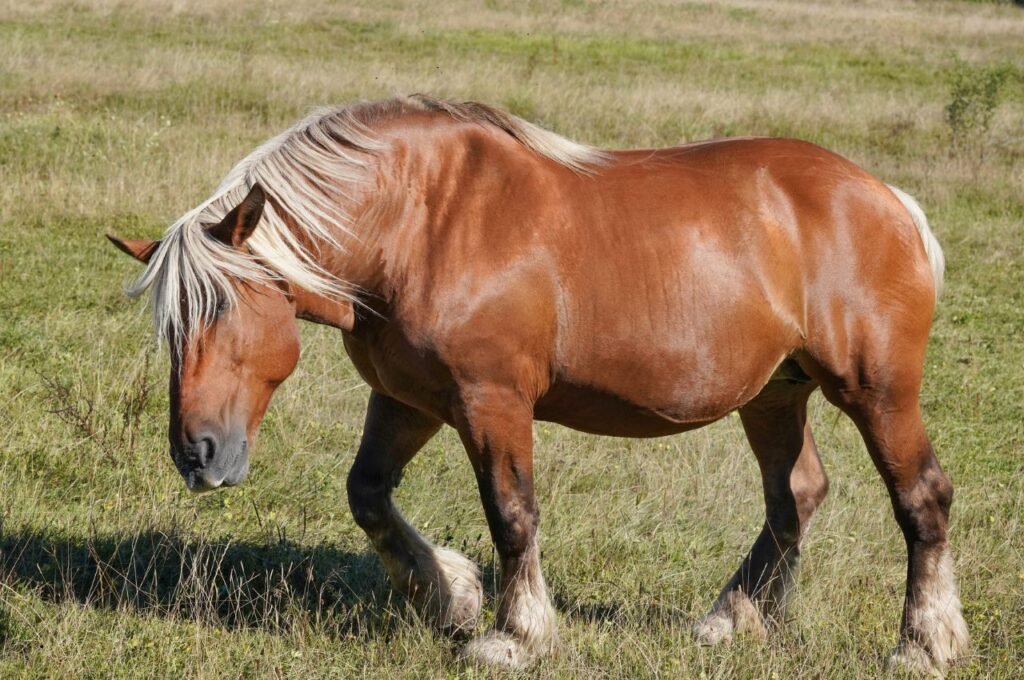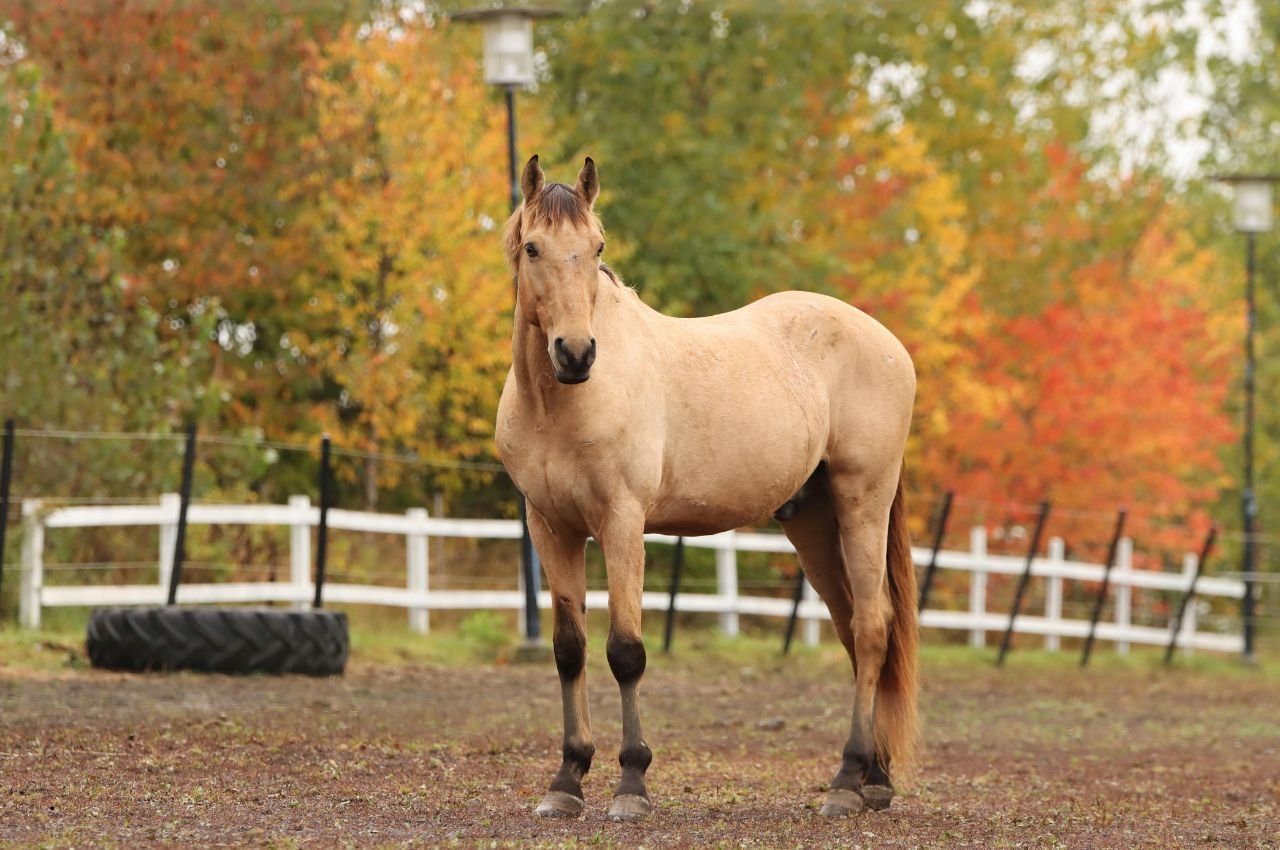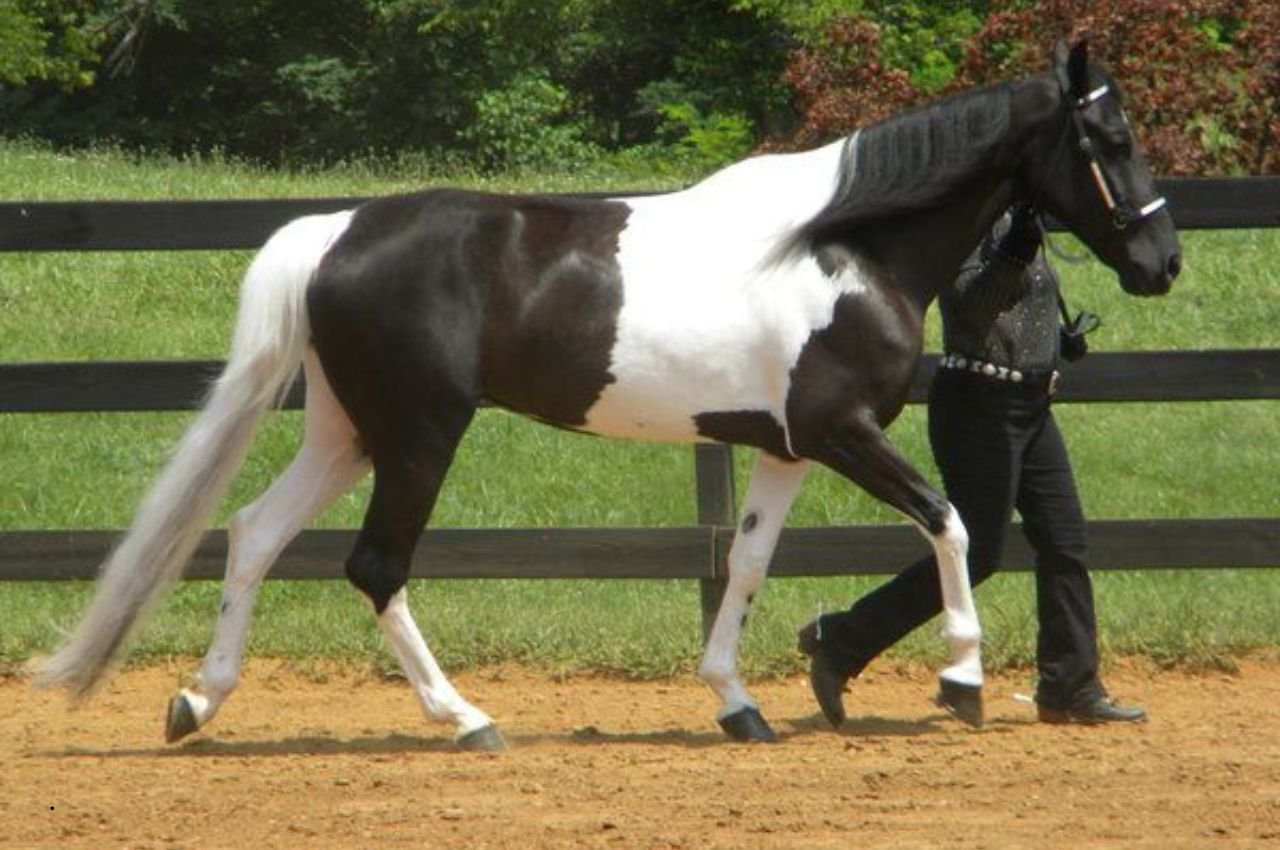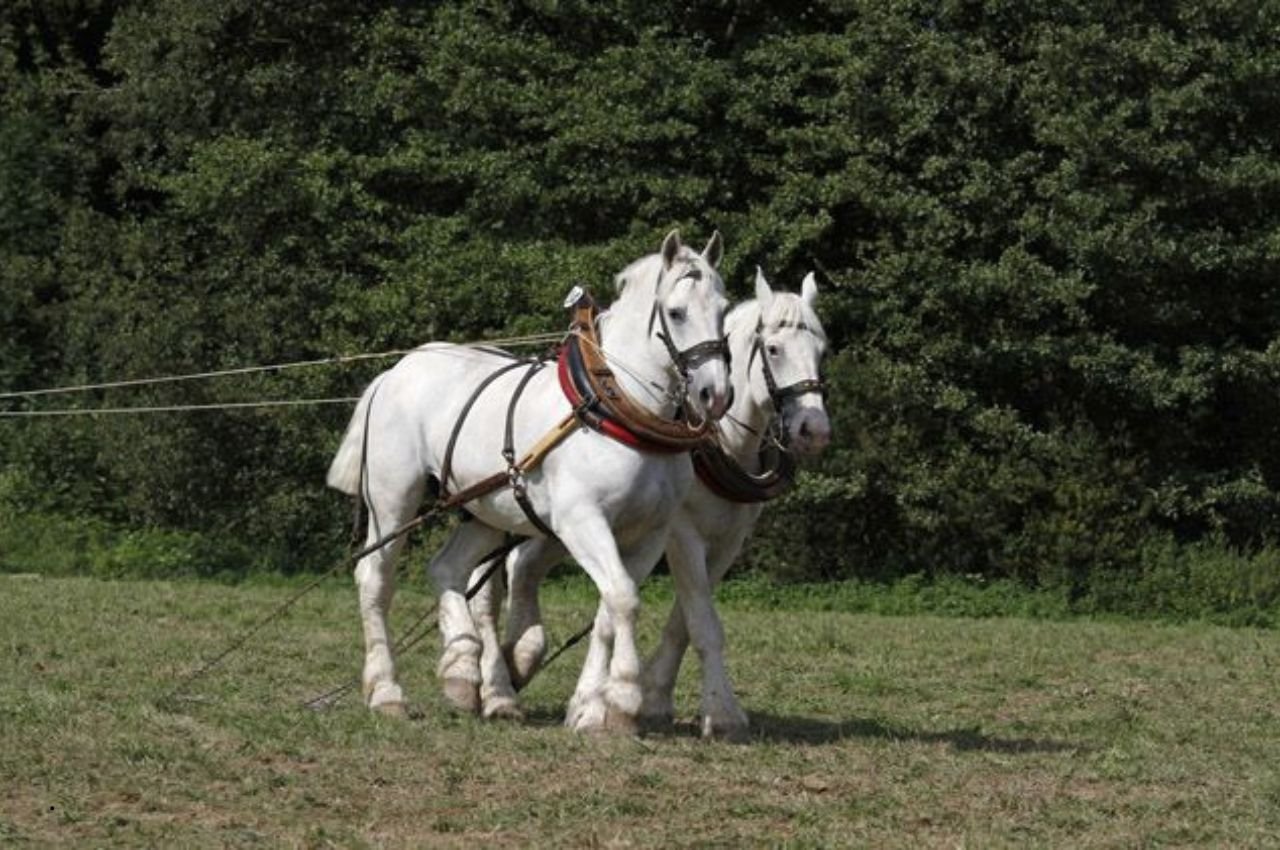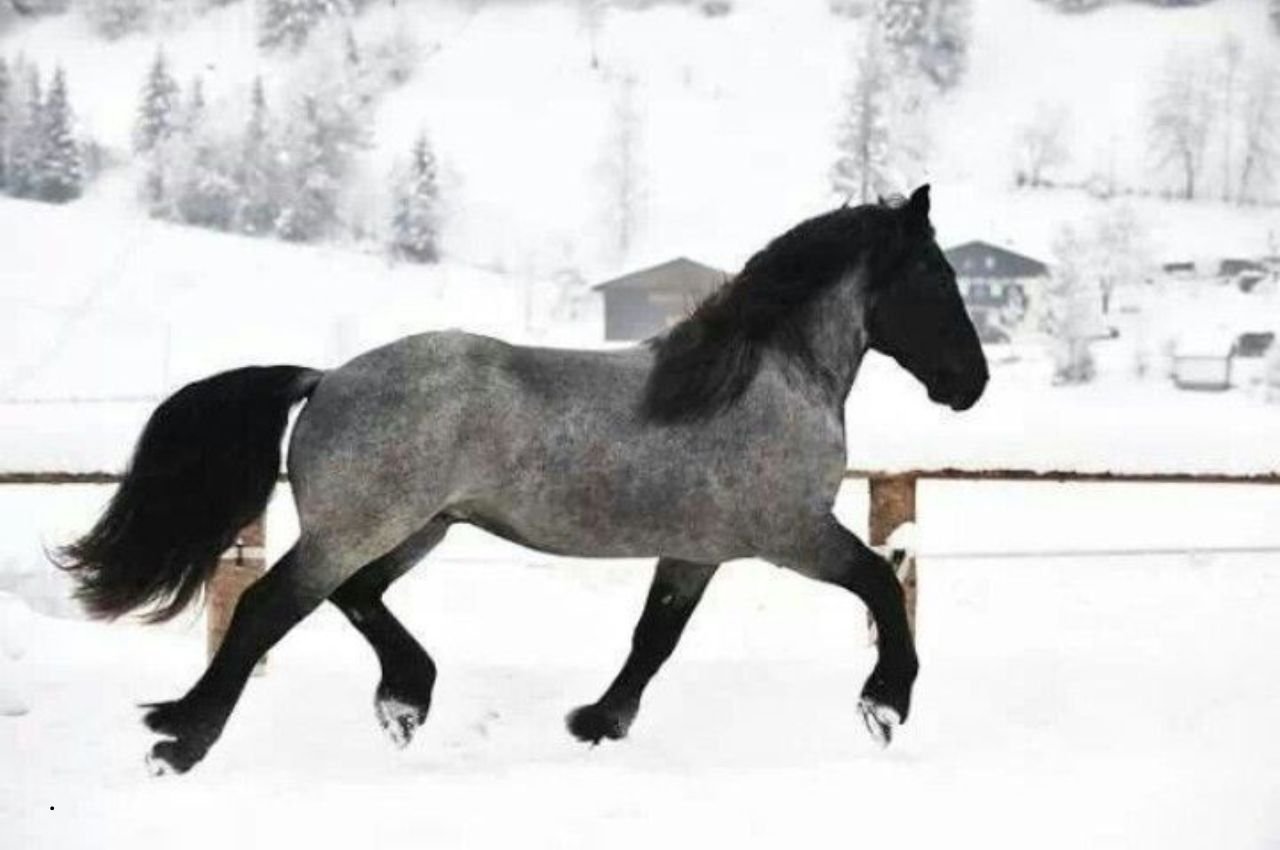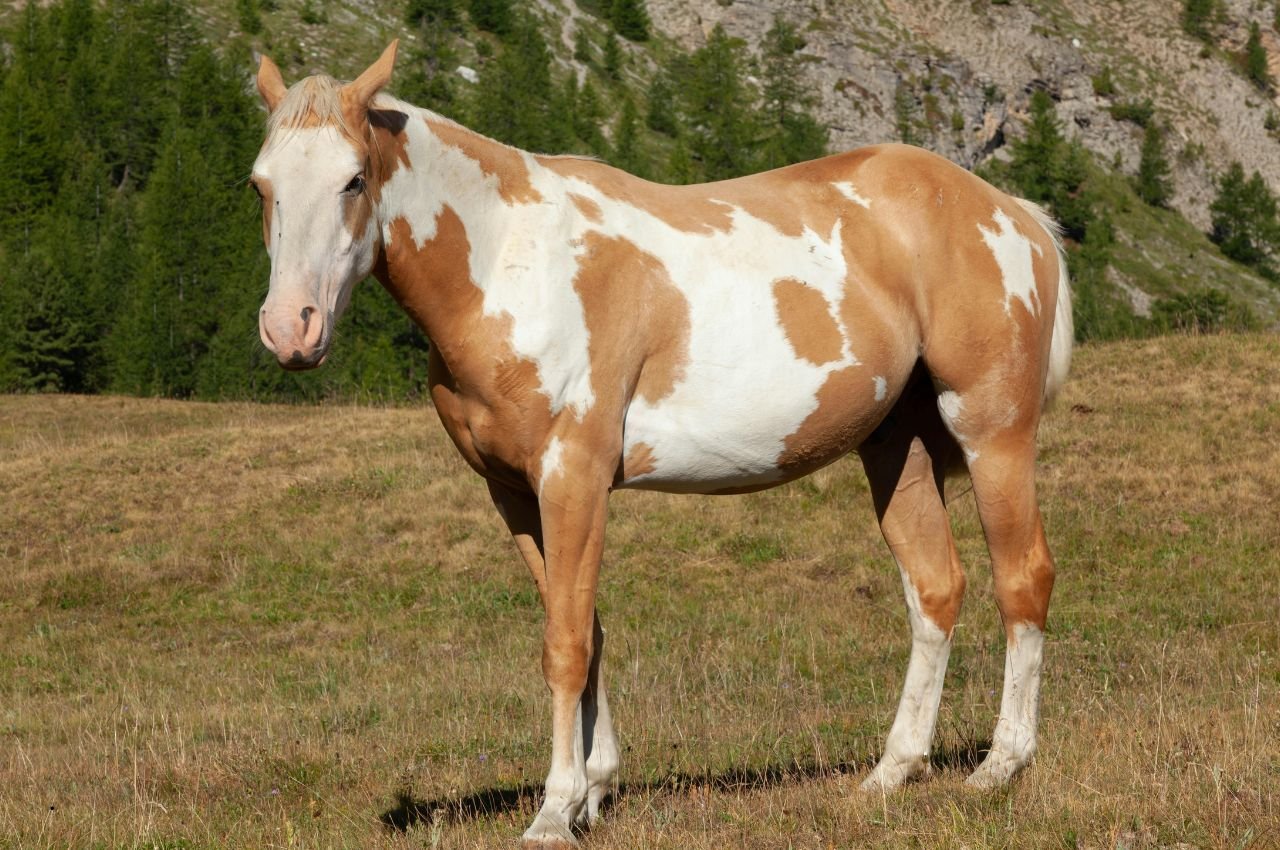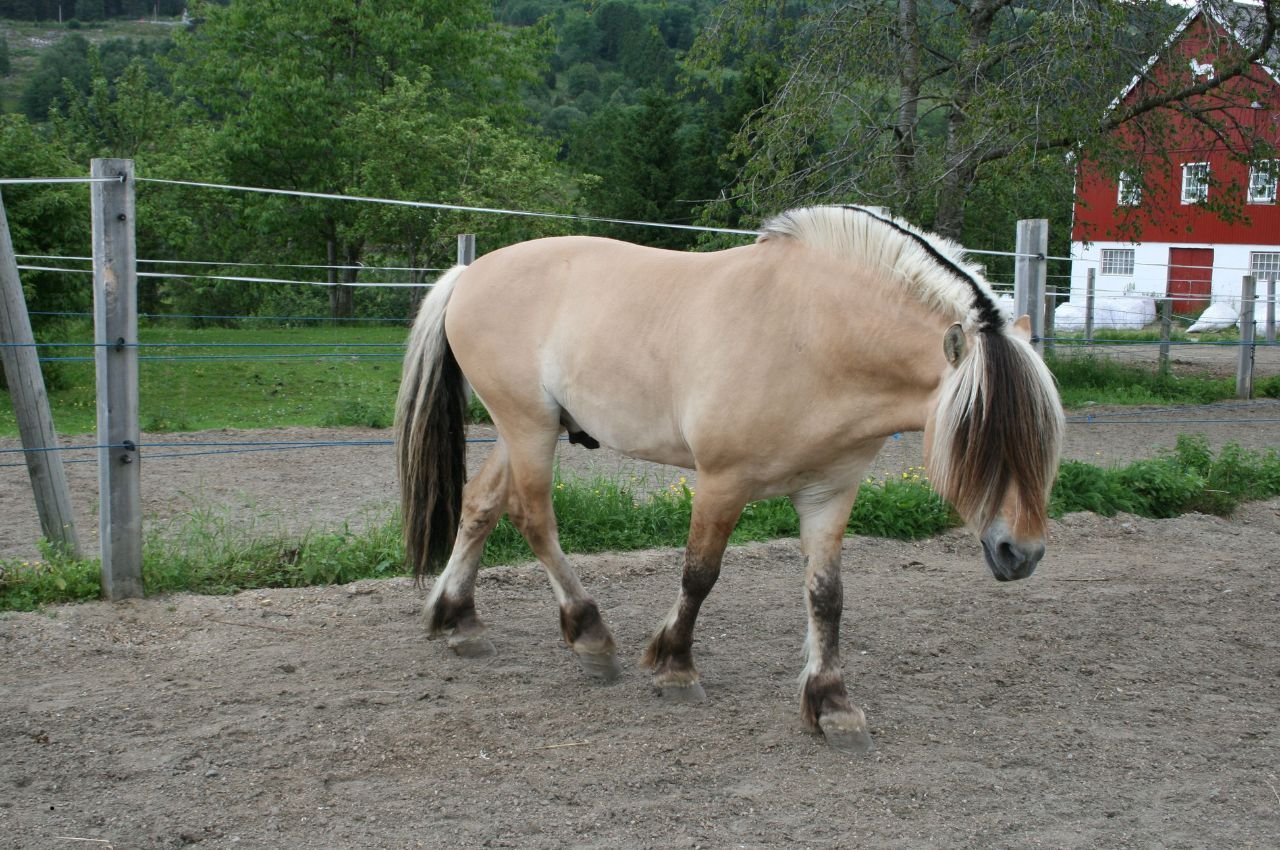The Comtois Horse stands as one of France’s most distinguished and versatile draft breeds, embodying centuries of selective breeding that has produced a remarkably adaptable and hardworking equine. Known for their distinctive chestnut coloring with flaxen manes and tails, these robust horses represent the pinnacle of French draft horse breeding excellence. The origins of this ideal draft horse go back to the great “German Breed” imported by the Burgundians in the 5th century, making them one of Europe’s oldest continuously developed breeds.
What sets the Comtois apart from other European draft breeds is their unique combination of power, agility, and remarkable longevity. It is known for its strength, stamina, and calm temperament, making it an excellent workhorse for both agricultural and forestry tasks. These characteristics have made them invaluable partners in the mountainous regions of eastern France, where their sure-footedness and endurance are legendary among working horse enthusiasts.
Table of Contents
Historical Origins and Development
The fascinating history of the Comtois Horse spans over fifteen centuries, making it one of the most historically significant horse breeds in Europe. The Comtois is thought to have evolved from horses brought by the Germanic Burgundian tribe to France during the 4th century, establishing a foundation that would be refined over generations through careful selective breeding programs.
Ancient Foundations and Early Development
The breed’s roots trace back to when the Burgundian tribes migrated westward, bringing with them sturdy horses adapted to harsh climates and difficult terrain. These early horses possessed the hardiness and strength that would become hallmarks of the modern Comtois breed. The oriental stallions belonging to the Spaniards who occupied the Franche-Comté region brought it the characteristics which continue to shape the Comtois breed.
The systematic development of the breed began in earnest during the medieval period, when French horse breeders recognized the potential of these hardy mountain horses. The geographical isolation of the Franche-Comté region provided an ideal environment for developing a distinct breed type, with the challenging terrain serving as a natural selection pressure that favored sure-footed, strong, and intelligent horses.
Renaissance and Modern Refinement
During the Renaissance period, the Comtois breed underwent significant refinement as French nobility and wealthy merchants invested in improving their horse stock. In the 1500s, these horses were used for refining the Burgundian horses, demonstrating their value as foundation stock for other breeding programs.
The establishment of formal breeding programs in the 18th and 19th centuries marked a turning point for the breed. French agricultural reformers recognized that standardizing and improving draft horses would be crucial for modernizing farming practices. The Comtois, with its proven work ethic and adaptability, became a cornerstone of these efforts.
The breed’s official recognition and the establishment of its stud book solidified its status as one of France’s premier draft breeds. This formal recognition ensured that breeding practices would maintain the qualities that made the Comtois so valuable while allowing for continued improvement through careful genetic selection.
Physical Characteristics and Conformation
The Comtois Horse presents a distinctive and immediately recognizable appearance that reflects its heritage as both a powerful draft animal and an agile mountain horse. The Comtois is a light draft horse, with a large head, straight neck, stocky and powerful body and deep girth, creating a profile that emphasizes both strength and balance.
Size and Build
Comtois horses typically stand between 15 and 16 hands high and have a stocky build with a broad chest, powerful hindquarters, and strong legs. This size range places them in the category of medium draft horses, making them more versatile than some of the larger European draft breeds while maintaining substantial power and pulling capacity.
The breed’s weight typically ranges from 600 to 800 kg (1,320 to 1,760 pounds), with this substantial mass distributed across a well-balanced frame that enables both power and agility. Their compact build makes them particularly well-suited for working in confined spaces and navigating challenging terrain.
Head and Neck Structure
The Comtois head is characterized by its substantial size and intelligent expression, reflecting the breed’s reputation for trainability and cooperation. The straight profile and alert ears indicate the breed’s Arab influences, which were introduced during various periods of the breed’s development.
The neck conformation is straight and muscular, providing the leverage necessary for draft work while maintaining the flexibility required for more refined movements. This balance between power and mobility is a key characteristic that distinguishes the Comtois from purely heavy draft breeds.
Body and Limb Conformation
They have long, straight backs and short, strong legs with a little feathering and muscular hindquarters. The back length provides excellent weight-carrying capacity while maintaining structural soundness, a crucial factor in the breed’s legendary longevity and working ability.
The leg conformation deserves special attention, as The Comtois sometimes shows a tendency towards sickle hocks. While this conformational trait requires careful evaluation in breeding stock, it doesn’t typically impact the breed’s working ability when present in mild forms. Modern breeding programs work to minimize this trait while preserving the breed’s other valuable characteristics.
Color and Markings
Their coat is usually chestnut or bay, often with a flaxen mane and tail. This distinctive coloring is one of the breed’s most recognizable features, with the flaxen or silver-dapple coat being particularly prized among breed enthusiasts.
The consistency of color within the breed reflects centuries of selective breeding for this attractive and distinctive appearance. The chestnut base with flaxen points creates a striking contrast that has made the Comtois popular not only as a working horse but also as a driving and pleasure horse.
Temperament and Working Characteristics
The Comtois Horse is renowned for possessing an ideal combination of power, intelligence, and tractability that makes it exceptionally valuable for both work and pleasure activities. Characteristics of the Comtois horse are liveliness, energy, and endurance, with a trainable temperament, creating a horse that is both capable and enjoyable to work with.
Mental Characteristics
Its hardworking nature, gentle disposition, and adaptability make it a standout among draft breeds. This combination of traits makes the Comtois particularly suitable for handlers of varying experience levels, from professional teamsters to recreational horse owners seeking a reliable and responsive partner.
The breed’s intelligence manifests in their ability to learn complex tasks quickly and retain training over long periods. This cognitive ability is particularly valuable in forestry and agricultural work, where horses must navigate changing conditions and adapt to new challenges.
Work Ethic and Endurance
The Comtois has earned a reputation for exceptional work capacity and longevity. The Comtois is still used in its mountain homeland for timber and vineyard work and is very long lived and capable of work in hilly terrain. This working ability in challenging terrain demonstrates the breed’s sure-footedness and stamina, qualities that were developed through generations of selection in the mountainous regions of eastern France.
Their endurance capabilities make them particularly valuable for sustained work efforts, whether in agricultural applications or forestry operations. The combination of strength and stamina allows Comtois horses to maintain consistent output over long working days, a crucial factor in their continued popularity among working horse advocates.
Adaptability and Versatility
Modern Comtois horses demonstrate remarkable adaptability to various roles and environments. While they excel in their traditional roles as farm horses and logging horses, they have also found success in competitive driving, pleasure riding, and even therapeutic programs.
Health and Wellness Considerations
The Comtois Horse is generally recognized as a hardy and healthy breed with excellent longevity, but like all horses, they benefit from comprehensive health management programs tailored to their specific needs and characteristics. Understanding the breed’s particular strengths and potential health considerations is essential for maintaining optimal wellness throughout their working lives.
Common Health Strengths
The Comtois breed exhibits several inherent health advantages that contribute to their reputation for longevity and durability. Their natural hardiness, developed through centuries of working in challenging mountain environments, has created horses with robust immune systems and excellent disease resistance.
The breed’s moderate size and sound conformation contribute to their structural soundness and reduced risk of many orthopedic issues that can affect larger draft breeds. Their balanced build and strong bone structure provide excellent support for their working activities while minimizing stress on joints and soft tissues.
Preventive Health Care
Establishing a comprehensive preventive health program is crucial for maintaining Comtois horses in optimal condition. This should include regular veterinary examinations, vaccination schedules appropriate for their geographic location and use, and consistent dental care to ensure proper feed utilization.
Parasite management requires particular attention, especially for horses maintained on pasture or working in environments where they may be exposed to various parasitic organisms. Regular fecal examinations and strategic deworming programs help maintain intestinal health and prevent performance-limiting parasitic loads.
Monitoring for Breed-Specific Considerations
While the Comtois is generally healthy, owners should be aware of the breed’s occasional tendency toward sickle hocks, as mentioned in their conformation characteristics. Regular monitoring of hind limb function and appropriate farrier care can help minimize any potential impact of this conformational variation.
The breed’s working heritage means they benefit from consistent exercise and activity. Horses maintained in sedentary conditions may develop issues related to inactivity, including metabolic concerns and behavioral problems. Regular turnout and appropriate exercise programs help maintain physical and mental wellness.
Emergency Preparedness and First Aid
Comtois owners should maintain emergency preparedness protocols appropriate for their horse’s size and use. This includes having first aid supplies sized for large horses and establishing relationships with veterinarians experienced in draft horse care.
Understanding basic vital signs and lameness evaluation techniques enables owners to make informed decisions about when professional veterinary care is needed and can help prevent minor issues from becoming major problems.
Nutritional Requirements and Feeding Management
Proper nutrition forms the foundation of health and performance for Comtois horses. Their moderate size and efficient metabolism make them relatively economical to feed compared to larger draft breeds, but their nutritional program must be carefully designed to meet their energy requirements while preventing obesity and metabolic issues.
Basic Nutritional Principles
Forage intake should be at least 1% of body weight (5 kg or 11 lb for a 500 kg / 1,100 lb horse) per day, establishing the foundation for any Comtois feeding program. For a typical Comtois horse weighing 650-750 kg (1,430-1,650 pounds), this translates to a minimum daily forage requirement of 6.5-7.5 kg (14.3-16.5 pounds) of high-quality hay or equivalent pasture intake.
So, a 1000 pound horse would need an average of 2% or 22# of feed per day, though this can vary significantly based on individual metabolism, work load, and body condition. The total daily feed intake for most Comtois horses should fall between 1.5% and 3% of body weight, with the majority coming from forage sources.
Energy Requirements and Work Considerations
Hard work may increase intake needs by a factor of 1.8, making it essential to adjust feeding programs based on the horse’s activity level. Working Comtois horses engaged in forestry operations or intensive agricultural work will require significantly more energy than horses maintained for light riding or driving activities.
Energy Requirement: Approximately 150 to 180+ MJ/day for a 500 kg horse. High-performance horses may require more than 100% additional energy compared to maintenance levels. For Comtois horses, this translates to careful monitoring of body condition and adjustment of concentrate feeding based on workload demands.
Protein and Growth Considerations
Protein requirements for growth and maintenance vary depending on age and workload. In general, growing horses need a higher percentage of protein than mature horses. A growing horse generally needs between 12 and 18 percent crude protein in its diet for proper growth and development.
Mature Comtois horses typically require 8-10% crude protein in their total diet for maintenance, with working horses needing 10-12% depending on intensity of use. High-quality forage sources like alfalfa hay or quality grass hay can often meet or substantially contribute to protein requirements without additional supplementation.
Forage Management and Quality
Horses fed high-fibre diets show fewer unwanted behaviours in the stable and under saddle than those fed low-fibre diets. Ideally, horses should have constant access to forage. This principle is particularly important for Comtois horses, whose mountain heritage has adapted them to continuous grazing patterns.
Management practices to decrease the risk of impaction include ad lib access to fresh water, adequate exercise, good quality feed, and good dental care. The breed’s efficient digestion system benefits from consistent forage availability and high-quality water sources.
Concentrate and Supplement Considerations
High energy grain mixes intended to be fed with forage are usually formulated to contain between 1.3 to 1.6 Mcal DE/lb of feed. When concentrate feeding becomes necessary for working Comtois horses, selection should focus on feeds designed for draft breeds or moderate-energy feeds that provide necessary nutrients without promoting excessive weight gain.
Vitamin and mineral supplementation should be based on forage analysis and regional soil conditions. Many Comtois horses maintained on quality pasture or hay may require minimal supplementation beyond a basic mineral supplement to balance potential deficiencies in their primary forage sources.
Management and Housing Requirements
Successful Comtois horse management requires understanding their heritage as hardy, outdoor-adapted animals while providing appropriate care for their size and intended use. These horses generally thrive under management systems that allow for natural behaviors while protecting them from extreme weather conditions.
Shelter and Housing Systems
Comtois horses adapt well to various housing systems, from simple three-sided shelters in pasture settings to more elaborate barn facilities. Their hardy nature means they require less intensive shelter than many breeds, though working horses benefit from protection that allows them to stay dry and comfortable during off-work periods.
Stall dimensions for Comtois horses should accommodate their moderate draft horse size, typically requiring stalls of at least 12′ x 12′ (3.7m x 3.7m) for comfortable movement and lying down. Larger stalls of 12′ x 14′ or 14′ x 14′ are preferable for horses that spend extended periods stalled.
Pasture Management and Turnout
Breeding has spread to the Massif Central, demonstrating the breed’s adaptability to various geographical regions and management systems. Pasture requirements typically range from 1-2 acres per horse for maintenance, though this varies significantly based on pasture quality, climate, and seasonal growth patterns.
The breed’s mountain heritage makes them excellent candidates for rotational grazing systems, where their sure-footedness allows them to utilize varied terrain effectively. Group turnout is generally well-tolerated, as Comtois horses typically display calm, social temperaments that work well in herd situations.
Fencing and Safety Considerations
Appropriate fencing for Comtois horses should be sturdy enough to contain horses weighing 600-800 kg while being safe for daily interaction. Board fencing, post and rail systems, and high-tensile wire with appropriate visibility modifications all work well for this breed.
Electric fencing can be effective for temporary or semi-permanent installations, though it should be combined with visible barriers to ensure safety. The breed’s calm temperament generally means they respect fencing well once properly introduced to electric systems.
Climate Considerations
The Comtois breed’s cold weather hardiness reflects their mountain origins, making them well-suited to cooler climates with minimal additional care. However, working horses or those in intensive management benefit from blanketing systems during severe weather to maintain body condition and reduce energy expenditure for thermoregulation.
Heat management becomes more critical in warmer climates, where providing adequate shade, ventilation, and water access helps prevent heat stress and maintains performance levels.
Training and Work Applications
The Comtois horse’s combination of intelligence, strength, and tractability makes them exceptionally versatile in training applications. Their heritage as working horses provides them with inherent understanding of teamwork and cooperation, while their moderate size makes them more manageable than some larger draft breeds.
Foundation Training Principles
Ground training forms the essential foundation for all Comtois training programs. Their intelligent nature means they respond well to consistent, patient instruction that builds trust and communication between horse and handler. Positive reinforcement techniques work particularly well with this breed, as they are naturally cooperative and eager to please.
Basic handling skills including leading, tying, grooming, and hoof care should be thoroughly established before advancing to more complex training. The breed’s size requires handlers to be confident and consistent, as unclear communication can lead to confusion and potential safety issues.
Draft Work and Driving Training
Traditional draft training remains highly relevant for modern Comtois horses, whether intended for agricultural work, forestry operations, or recreational driving. The systematic approach of ground driving allows horses to learn voice commands and rein aids while developing the muscle memory needed for pulling loads.
Harness training should progress gradually, with careful attention to proper harness fitting for the horse’s conformation. Comtois horses typically adapt quickly to harness work, though their strength means that proper equipment selection and maintenance are crucial for safety and effectiveness.
Modern Applications and Competitive Training
Many modern Comtois horses excel in competitive driving events, where their combination of power, agility, and trainability provides significant advantages. Combined driving competitions showcase the breed’s versatility, requiring precision, athleticism, and partnership between horse and driver.
Pleasure driving training emphasizes comfort, safety, and enjoyment for both horse and handler. Comtois horses often excel in this discipline due to their calm temperaments and smooth gaits, making them popular choices for recreational driving and therapeutic driving programs.
Riding Training Considerations
While primarily known as driving horses, many Comtois horses adapt well to riding disciplines. Their calm temperaments and steady gaits make them suitable for trail riding, though their size and build are better suited to experienced riders who appreciate their unique characteristics.
Training under saddle should account for their draft horse build and movement patterns. While they may not have the athletic ability of sport horse breeds, their reliability and steady temperaments can make them excellent therapeutic riding horses or beginner-safe mounts for confident riders.
Modern Uses and Applications
The versatility that has defined the Comtois breed throughout its history continues to serve them well in contemporary applications. Whether used for agriculture, driving, or just as a companion, the Comtois continues to hold a special place in French culture and is loved by horse enthusiasts worldwide.
Traditional Agricultural and Forestry Work
The Comtois is still used in its mountain homeland for timber and vineyard work, demonstrating the continued relevance of horse power in specialized applications where machinery cannot operate effectively or sustainably. Modern sustainable farming operations increasingly recognize the benefits of horse-powered agriculture, particularly in organic farming systems and small-scale market gardens.
Forestry applications remain particularly important, as horses can access areas where heavy machinery would cause environmental damage. Selective logging operations benefit from the horse’s ability to navigate carefully through forested areas while minimizing soil compaction and damage to remaining trees.
Vineyard work represents a growing application where the Comtois breed’s sure-footedness and moderate size provide advantages over both machinery and larger horses. The precision required for vineyard cultivation matches well with the breed’s intelligence and trainability.
Recreation and Sport Applications
The Comtois breed has found increasing popularity in recreational applications, where their calm temperaments and distinctive appearance make them attractive to diverse audiences. Carriage driving represents a significant use, both for commercial operations and private enthusiasts.
Draft horse shows and competitions provide venues for showcasing the breed’s qualities while preserving traditional skills and knowledge. These events help maintain public interest in draft breeds while providing breeding guidance through conformation classes and performance evaluations.
Tourism and Educational Programs
Agritourism operations increasingly incorporate Comtois horses to provide authentic educational experiences about traditional farming methods and horse-human partnerships. Farm demonstrations and educational programs help preserve knowledge about working horses while engaging urban populations with agricultural heritage.
Therapeutic programs benefit from the breed’s calm temperament and steady movements, making them valuable partners in equine-assisted therapy and therapeutic driving programs. Their size requires specialized training and facilities but can provide unique benefits for appropriate clients.
Conservation and Breeding Programs
Modern conservation efforts recognize the Comtois as an important genetic resource representing centuries of selective breeding for specific traits. Genetic diversity programs work to maintain breed characteristics while preventing inbreeding and preserving the qualities that have made the breed successful.
International breeding programs have established Comtois populations outside France, helping ensure the breed’s long-term survival while adapting to different climates and management systems. These programs require careful coordination to maintain breed integrity while allowing for adaptation to local conditions.
Breeding and Genetics
Understanding the genetic principles and breeding practices that have shaped the Comtois breed is essential for anyone involved in breed preservation or improvement. The breed’s long history provides valuable lessons about maintaining genetic diversity while preserving desirable characteristics.
Genetic Heritage and Diversity
The Comtois breed benefits from its diverse genetic foundation, which includes influences from Germanic horses, Oriental bloodlines, and various European draft breeds. This genetic diversity has contributed to the breed’s hardiness and adaptability while providing the foundation for continued improvement.
Modern genetic testing allows breeders to make more informed decisions about mating selections while monitoring for potential genetic issues. DNA analysis can help verify parentage, assess genetic diversity, and screen for hereditary conditions that might affect the breed.
Breeding Objectives and Selection Criteria
Contemporary Comtois breeding programs focus on maintaining the breed’s traditional characteristics while improving traits that enhance their modern utility. Key selection criteria include conformation that supports working ability, temperament traits that ensure tractability, and soundness characteristics that promote longevity.
Performance testing provides objective measures of working ability, helping breeders select parents that will produce offspring suited to intended uses. Traditional traits like pulling ability, endurance, and sure-footedness remain important selection criteria.
Reproductive Management
Successful breeding programs require careful attention to reproductive management, including mare care, stallion management, and foal development. The breed’s generally good fertility and maternal instincts contribute to successful breeding operations.
Artificial insemination and embryo transfer technologies allow for more efficient use of superior genetics while reducing disease transmission risks. However, many Comtois breeders continue to use natural breeding methods that align with traditional practices.
Health Monitoring and Veterinary Care
Comprehensive health management for Comtois horses requires understanding both general equine health principles and the specific needs of this hardy draft breed. Their mountain heritage has created horses with robust constitutions, but modern management practices and regular veterinary care ensure optimal health throughout their working lives.
Routine Health Monitoring
Regular health assessments should include daily observation of appetite, attitude, and basic functions, with more detailed examinations conducted weekly or monthly depending on the horse’s age, use, and risk factors. Owners should monitor vital signs including temperature (99-101°F), pulse rate (28-44 beats per minute), and respiration (8-16 breaths per minute) as baseline indicators of health status.
Body condition scoring using standardized scales helps ensure Comtois horses maintain optimal weight for their work demands and overall health. The breed’s efficient metabolism means they can easily become overweight on rich feeds, making regular condition assessment particularly important for preventing metabolic disorders.
Vaccination and Disease Prevention
Vaccination protocols should be developed in consultation with local veterinarians based on regional disease risks and the horse’s exposure level. Core vaccines typically include protection against tetanus, Eastern and Western equine encephalomyelitis, West Nile virus, and rabies, while risk-based vaccines may include protection against influenza, rhinopneumonitis, and strangles.
Biosecurity measures become particularly important for breeding operations and horses that travel frequently for work or competition. Simple practices like quarantine protocols for new arrivals and sanitation procedures for equipment and facilities can prevent disease outbreaks.
Specialized Veterinary Considerations
The Comtois breed’s working heritage means veterinary care should address the unique needs of horses in active use. Lameness evaluation techniques adapted for draft horses help identify and address issues before they become career-limiting problems. Regular joint assessments are particularly important for working horses.
Reproductive veterinary care for breeding stock requires understanding the breed’s normal reproductive patterns and potential complications. Comtois mares generally have good fertility and foaling ease, but professional management improves success rates and reduces risks.
Geriatric Care Considerations
The Comtois breed’s exceptional longevity means many horses remain active well into their twenties, requiring specialized geriatric care approaches. Older horses benefit from modified nutrition programs, adjusted exercise routines, and increased monitoring for age-related conditions.
Dental care becomes increasingly important with age, as proper mastication directly impacts nutrition absorption and overall health. Regular ophthalmologic examinations help detect and manage age-related vision changes that could impact safety and performance.
Frequently Asked Questions (FAQs)
General Breed Information
Q: What makes Comtois horses different from other French draft breeds? A: Comtois horses are distinguished by their moderate size, exceptional longevity, and mountain-bred sure-footedness. Unlike larger French draft breeds like the Percheron or Boulonnais, the Comtois maintains agility while providing substantial power. Their distinctive chestnut coloring with flaxen points and compact build make them immediately recognizable.
Q: How rare are Comtois horses outside of France? A: While most common in their native France, Comtois horses have been exported to various countries, though they remain relatively uncommon in North America. International breeding programs exist in several European countries, and growing interest in sustainable agriculture is increasing demand worldwide.
Q: Are Comtois horses suitable for beginners? A: Comtois horses have excellent temperaments that make them suitable for many beginners, but their draft horse size requires handlers with confidence and basic large horse experience. Their calm, cooperative nature is forgiving, but proper ground training and safety knowledge are essential.
Q: What is the average lifespan of a Comtois horse? A: Comtois horses are known for exceptional longevity, commonly living 25-30 years with proper care. Many remain productive workers well into their twenties, making them excellent long-term investments for both commercial and recreational applications.
Care and Management
Q: How much space do Comtois horses need? A: Minimum pasture requirements are typically 1-2 acres per horse for adequate forage and exercise, though more space is always beneficial. Their mountain heritage makes them excellent candidates for rough terrain and rotational grazing systems that maximize land use efficiency.
Q: Can Comtois horses live outdoors year-round? A: Yes, their hardy mountain breeding makes Comtois horses well-suited to outdoor living with appropriate shelter from severe weather. They typically require less intensive housing than many breeds, though working horses benefit from barn facilities that allow them to stay dry and comfortable.
Q: What type of fencing is best for Comtois horses? A: Sturdy fencing systems like board fencing or post and rail work best for their size and strength. Electric fencing can be effective when properly installed with visible barriers, as the breed generally respects boundaries well.
Q: Do Comtois horses require special equipment? A: While not requiring specialized equipment, their moderate draft size means standard horse equipment may be too small. Draft-sized halters, blankets, and harness are necessary for proper fit and comfort.
Feeding and Nutrition
Q: How much do Comtois horses typically eat per day? A: A typical Comtois horse requires 15-25 pounds of forage daily, plus concentrates if working. Their efficient metabolism means they often require less feed than larger draft breeds while maintaining good condition. Working horses may need supplemental grain to meet increased energy demands.
Q: Are Comtois horses prone to founder or laminitis? A: Like all horses, Comtois can develop laminitis, particularly if overfed or allowed unrestricted access to rich pastures. Their efficient metabolism requires careful pasture management and body condition monitoring to prevent weight-related problems.
Q: What supplements do Comtois horses typically need? A: Most Comtois horses maintained on quality forage need minimal supplementation beyond a basic mineral supplement to balance potential deficiencies. Working horses may benefit from additional vitamins and electrolyte supplementation during intensive use periods.
Q: Can Comtois horses maintain condition on pasture alone? A: Many Comtois horses can maintain excellent condition on good quality pasture without supplemental feeding, especially during growing seasons. However, working horses, pregnant mares, and horses on poor pasture will require additional nutrition.
Training and Work
Q: What type of work are Comtois horses best suited for? A: Comtois horses excel at forestry work, vineyard cultivation, sustainable farming, and carriage driving. Their combination of strength, agility, and sure-footedness makes them particularly valuable for work in challenging terrain.
Q: How long does it take to train a Comtois horse for driving? A: With their intelligent and cooperative nature, most Comtois horses can learn basic driving skills in 6-12 months, though mastery of complex tasks may take longer. Their willingness to learn and strong work ethic typically makes training enjoyable and efficient.
Q: Can Comtois horses be ridden as well as driven? A: While primarily bred for driving and draft work, many Comtois horses adapt well to riding disciplines. Their calm temperament and steady gaits make them suitable for trail riding and therapeutic riding programs.
Q: Are Comtois horses good for competitive driving? A: Yes, many Comtois horses excel in competitive driving events. Their athleticism, intelligence, and trainability provide advantages in combined driving and other precision driving disciplines.
Health and Breeding
Q: What health problems are common in Comtois horses? A: The Comtois is generally a very healthy breed with few genetic problems. The main conformational concern is their occasional tendency toward sickle hocks, which should be evaluated in breeding stock but rarely affects working ability when mild.
Q: At what age do Comtois horses typically mature? A: Comtois horses reach physical maturity around 4-5 years of age, similar to other draft breeds. However, their mental maturity and work ethic often develop earlier, allowing for careful training to begin around 3 years of age with light work starting at 4.
Q: How many foals do Comtois mares typically have? A: Comtois mares generally have good fertility and maternal instincts, typically producing one foal per year when bred annually. Many mares remain productive into their late teens, contributing to the breed’s reputation for longevity and reproductive soundness.
Q: Are there genetic tests available for Comtois horses? A: Modern genetic testing options continue to expand for all horse breeds. While specific tests for Comtois-related conditions are limited due to the breed’s general health, standard equine genetic screening panels can identify carriers of various hereditary conditions.
Conservation and Future Prospects
The Comtois breed’s future depends on maintaining its traditional characteristics while adapting to modern needs and applications. Conservation efforts focus on preserving genetic diversity, maintaining working ability, and promoting the breed’s unique qualities to new generations of horse enthusiasts.
Current Population Status
While exact global population figures vary, the Comtois maintains stable numbers within France and growing populations in other European countries. Breed registries work to maintain accurate records and coordinate breeding efforts to preserve genetic diversity while improving breed quality.
The breed’s continued use in traditional applications like forestry and vineyard work provides economic incentives for maintaining breeding programs, while growing interest in sustainable agriculture creates new opportunities for breed preservation.
Genetic Conservation Strategies
Modern conservation breeding programs utilize genetic testing and pedigree analysis to maintain genetic diversity while avoiding inbreeding. These scientific approaches help preserve the breed’s hardiness and working ability while allowing for continued improvement.
International cooperation between breed organizations ensures that isolated populations don’t lose genetic diversity and that breeding programs worldwide maintain breed integrity while adapting to local conditions.
Educational and Promotional Efforts
Educational programs that showcase the Comtois breed’s history, characteristics, and modern applications help maintain public interest and support for conservation efforts. Demonstration programs at agricultural fairs and heritage events introduce new audiences to the breed’s capabilities.
Youth programs that involve younger generations in draft horse activities help ensure future stewardship of the breed. Many 4-H clubs and educational institutions incorporate draft horses into their programs, creating opportunities for hands-on learning about traditional horse skills.
Conclusion
The Comtois Horse represents fifteen centuries of selective breeding that has produced one of the world’s most versatile and enduring draft breeds. Their combination of strength, intelligence, longevity, and tractability makes them valuable partners in applications ranging from traditional forestry and agriculture to modern recreational driving and therapeutic programs.
The breed’s remarkable adaptability has allowed them to transition from medieval war horses to modern working partners while maintaining the essential characteristics that have made them successful throughout their long history. Their moderate size, distinctive appearance, and excellent temperaments position them well for continued success in diverse applications as interest in sustainable practices and heritage breeds continues to grow.
For those considering Comtois horses, whether for work, recreation, or breeding, these remarkable horses offer a unique combination of historical significance and modern utility. With proper care, nutrition, and management, Comtois horses can serve as both productive partners and living connections to centuries of equestrian tradition.
The future of the Comtois breed depends on continued appreciation for their unique qualities and ongoing efforts to preserve their genetic heritage while adapting to contemporary needs. As the world increasingly values sustainable practices and traditional skills, the Comtois Horse is well-positioned to remain a valuable and cherished breed for generations to come.
References and Resources
For comprehensive breed information and historical background, Horse Breeds Pictures – Comtois Information provides detailed breed characteristics and visual identification guides.
Detailed breed registry and pedigree information can be found through Horse Isle – Comtois Breed Profile, offering interactive breed information and characteristics.
Contemporary breed applications and modern uses are documented at Small Farmers Journal – Comtois in France, providing insights into current breed utilization.
Historical and traditional uses are covered in Art by Crane – Draft Horse Breeds, offering comprehensive coverage of draft breed development.
Current breed status and characteristics are available through Horse Breeds UK – Comtois Information, providing modern perspectives on breed management.
Contemporary applications and working uses are documented at North Cote Horses – Comtois Draft Horse, offering practical information for modern owners.
Scientific research and genetic information can be found through various veterinary and genetic databases that provide ongoing research into draft breed genetics and health.
Professional feeding and nutrition guidance is available from equine nutrition specialists who provide research-based recommendations for draft horse feeding.
Training and management resources are available through draft horse organizations and working horse associations that promote traditional skills and modern applications.
This comprehensive guide provides general information about the Comtois Horse breed. Always consult with qualified veterinarians, equine nutritionists, and experienced horsemen for specific advice regarding individual horses and management situations.

